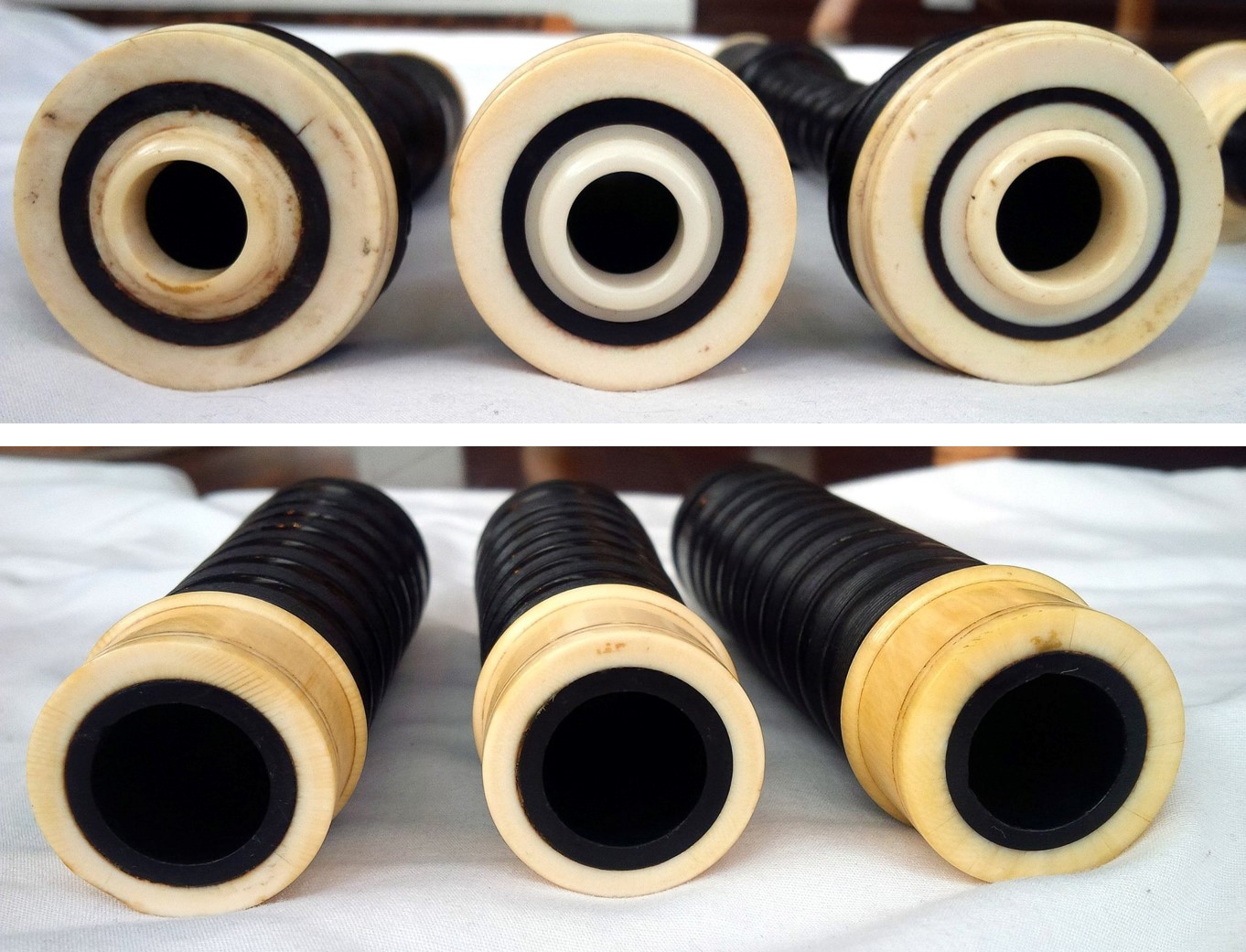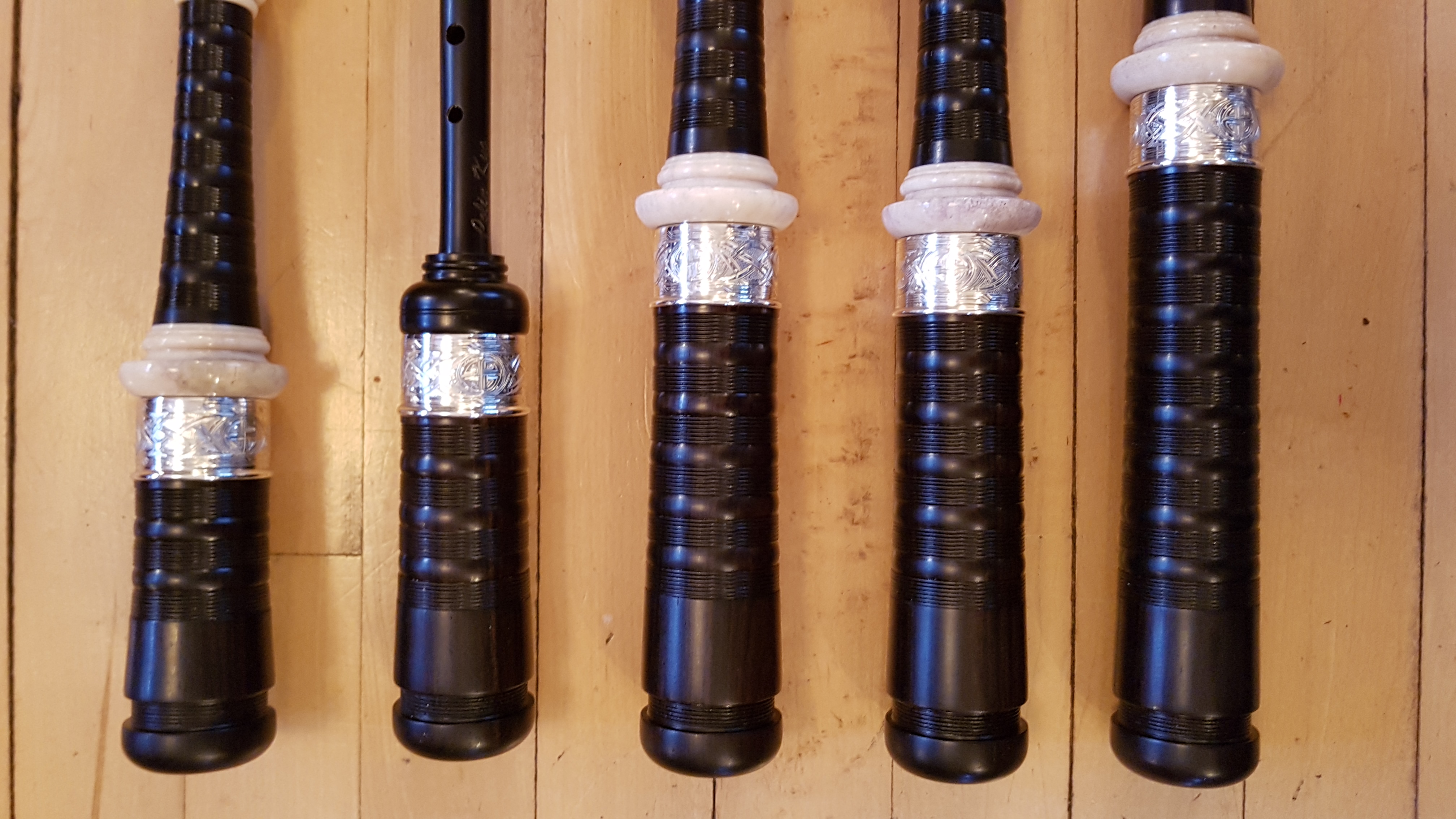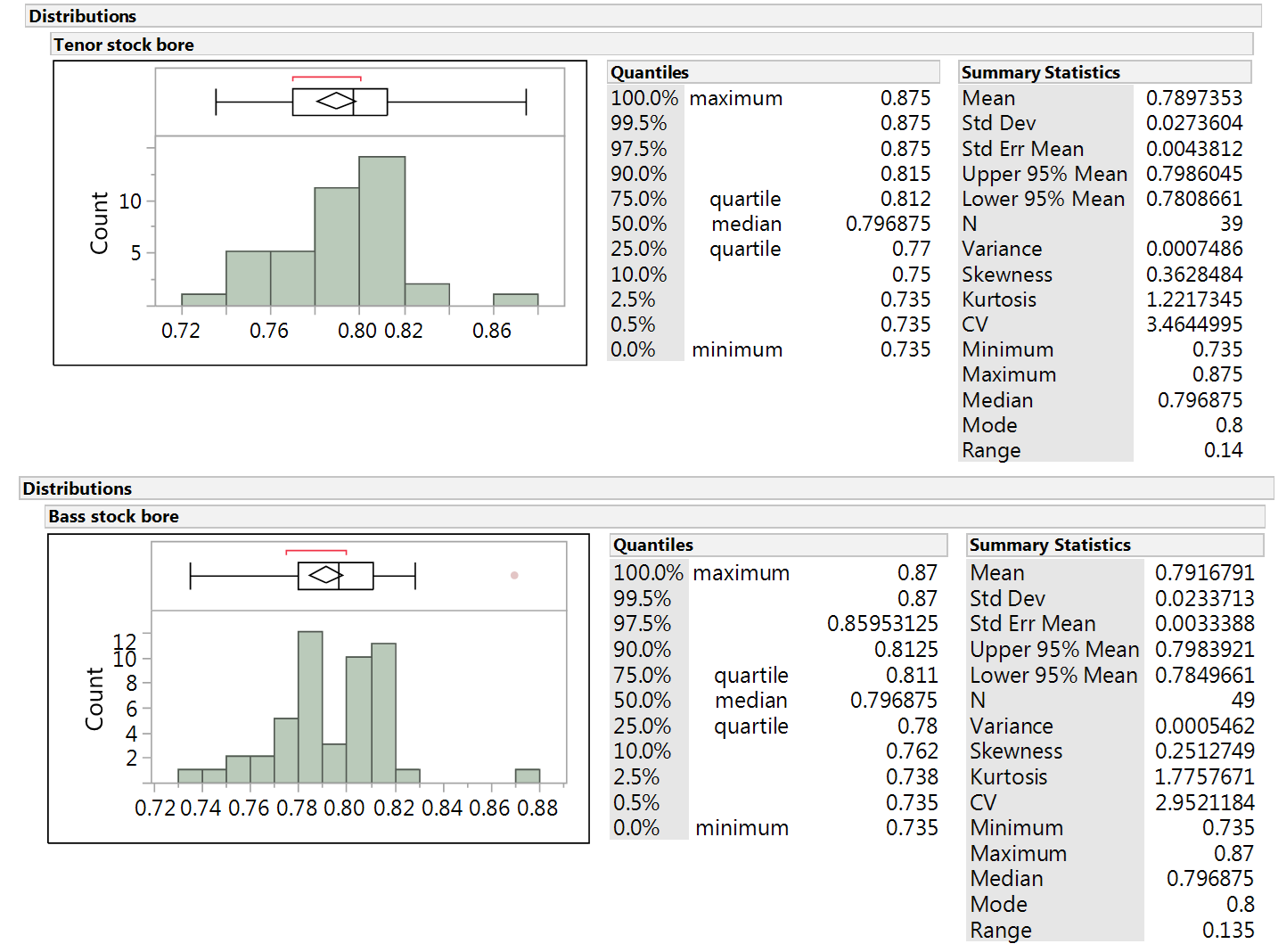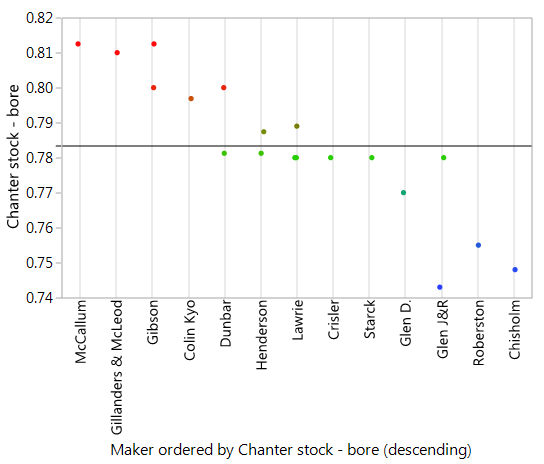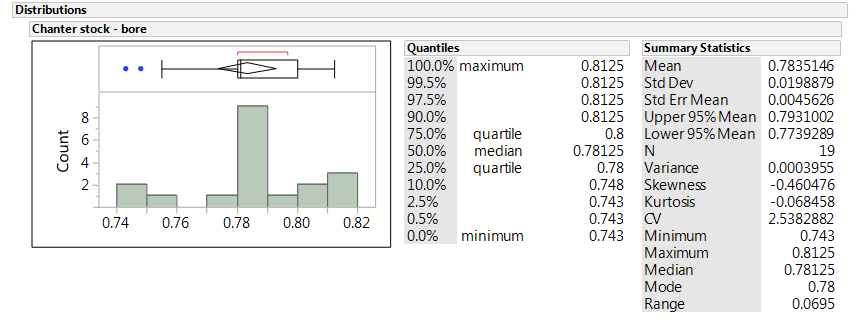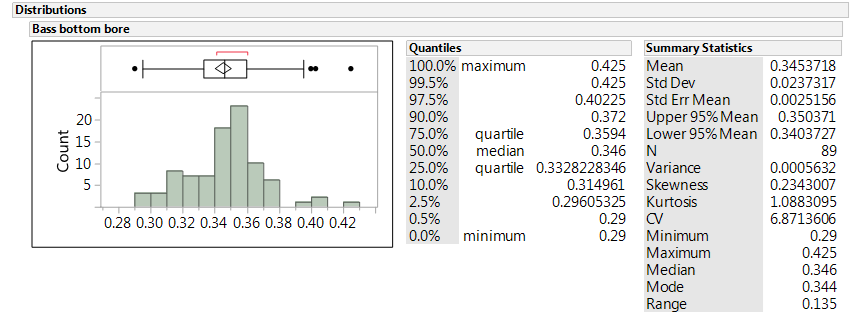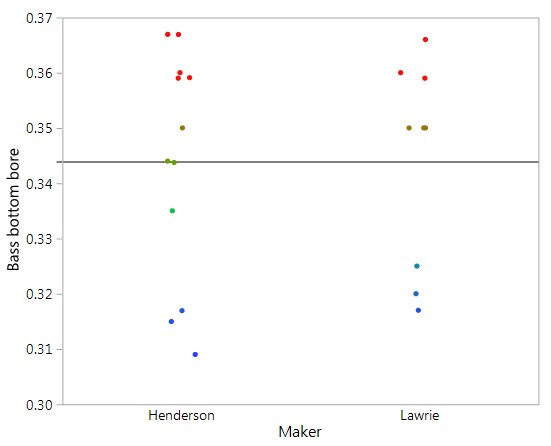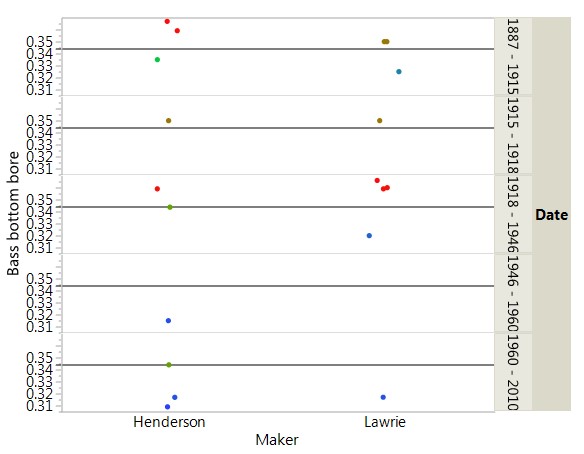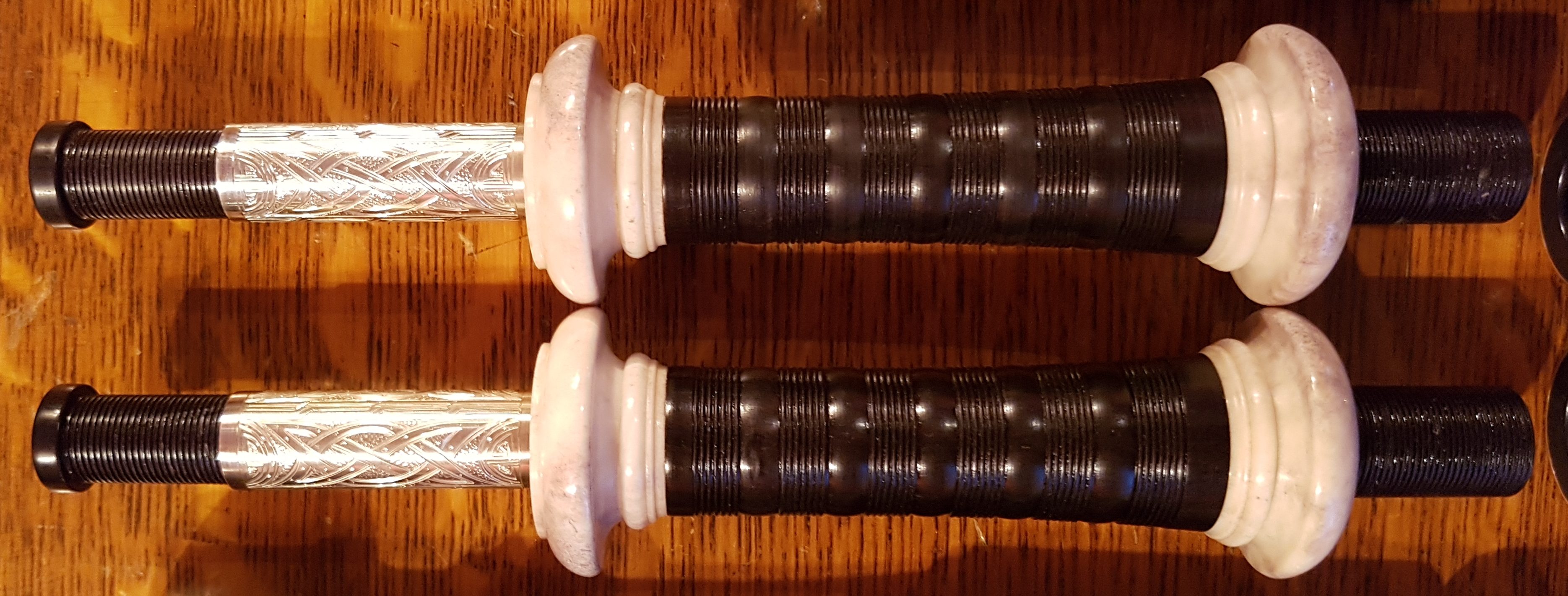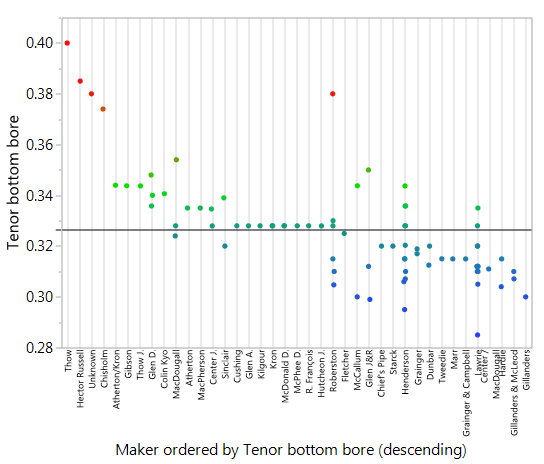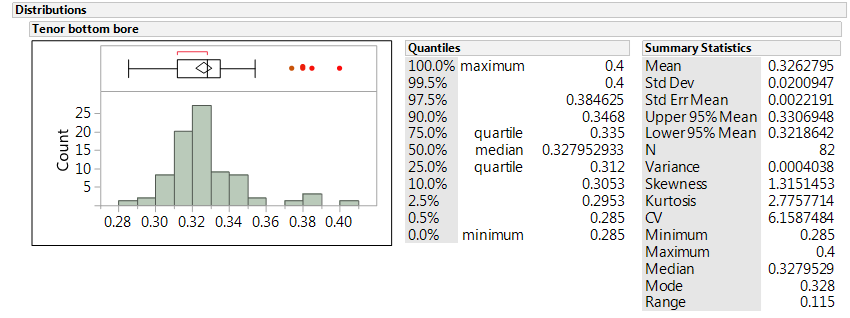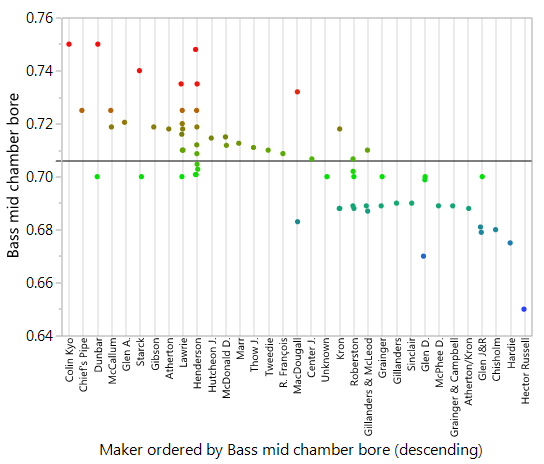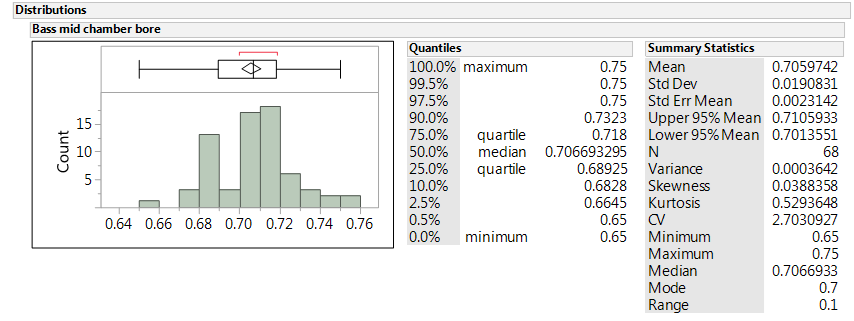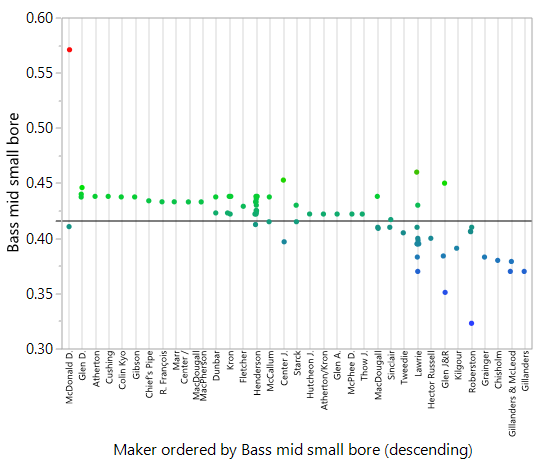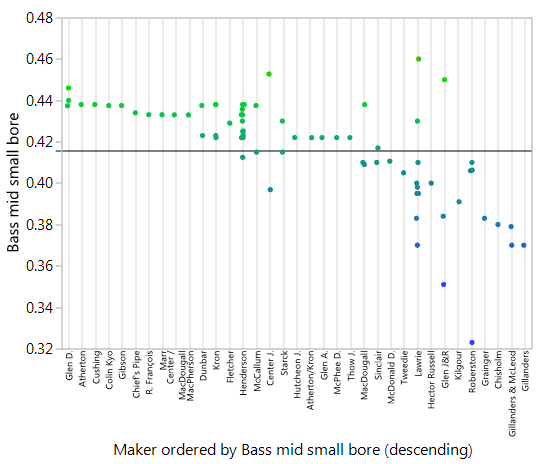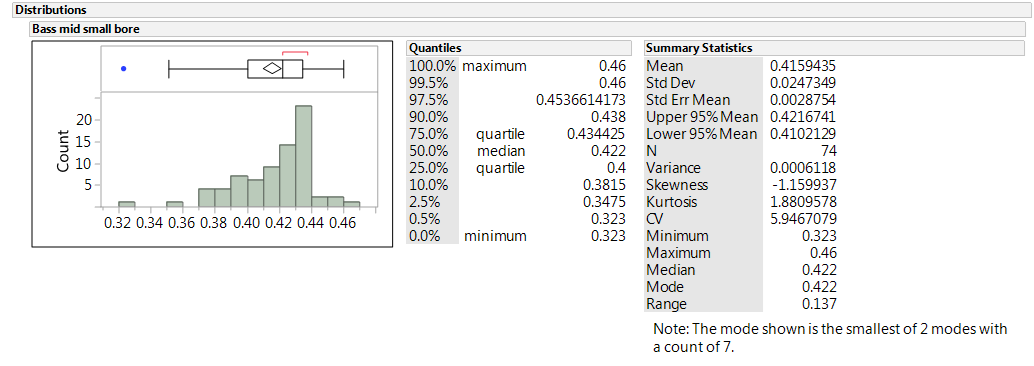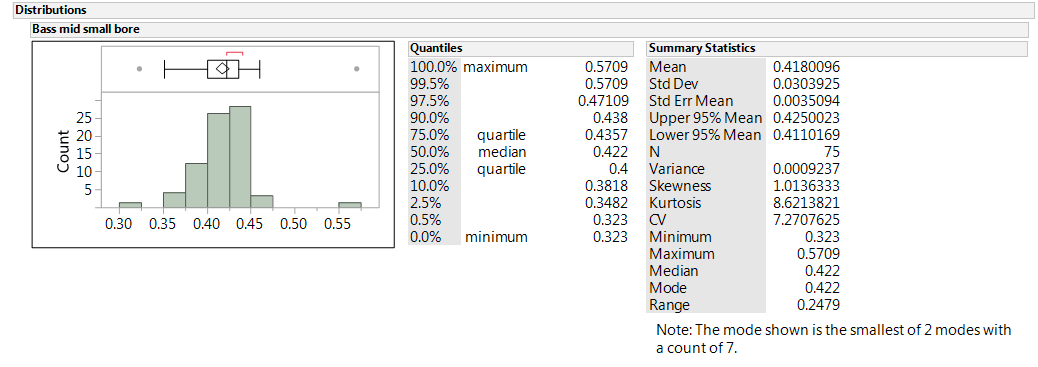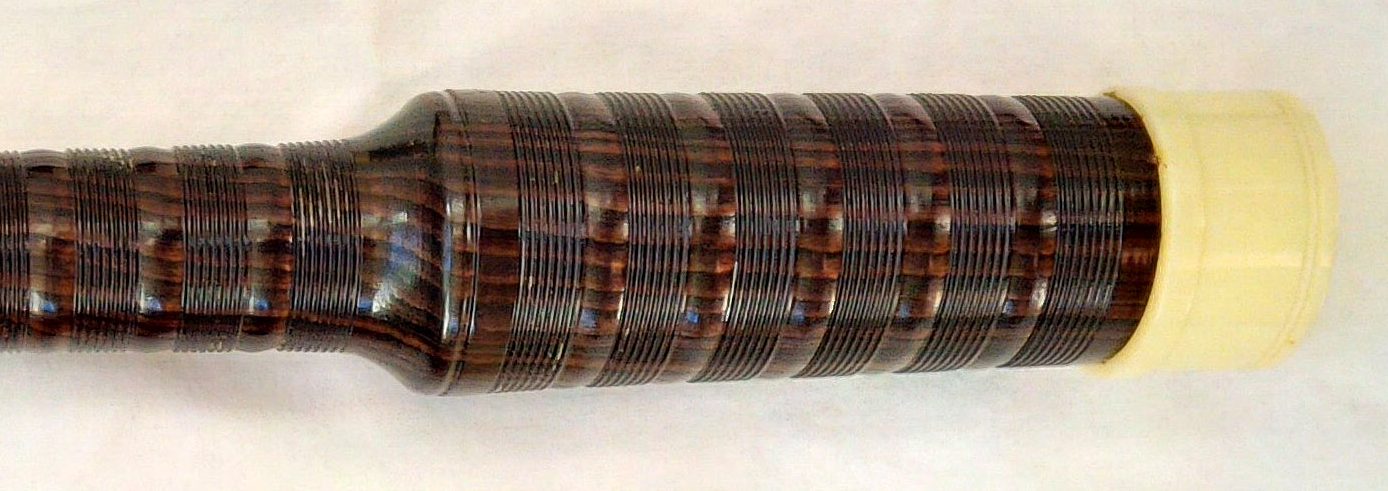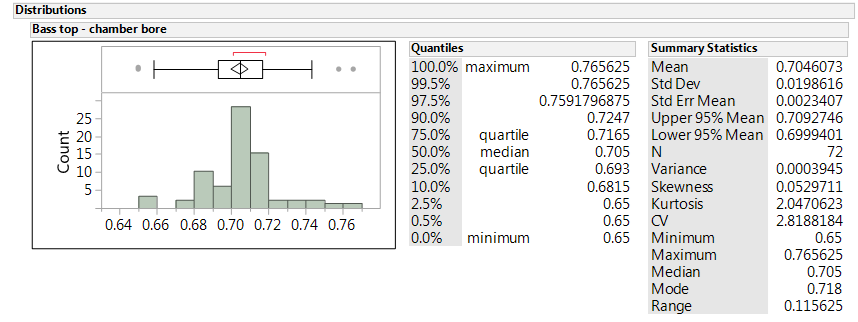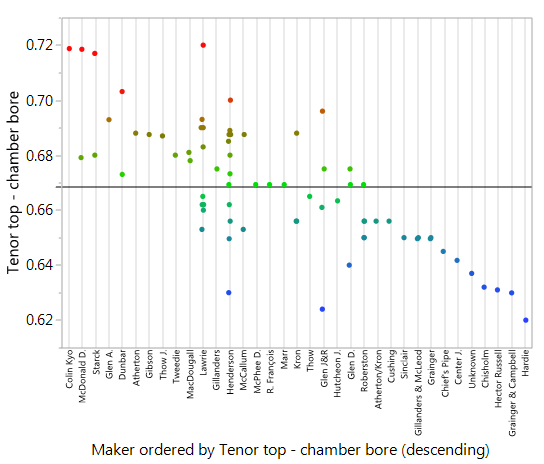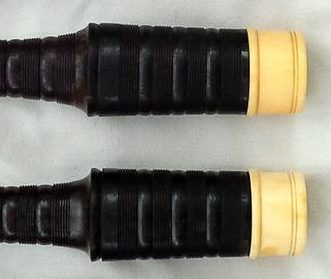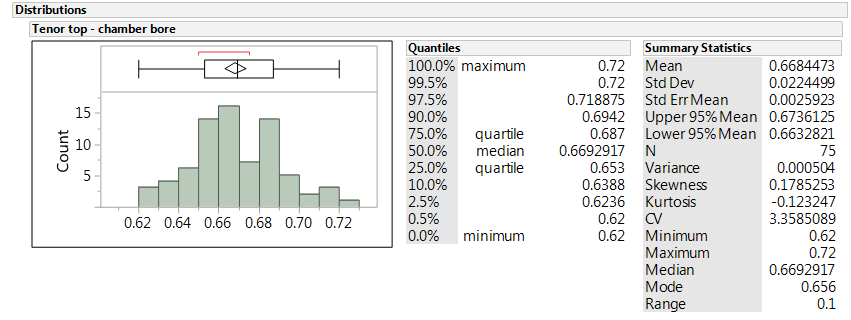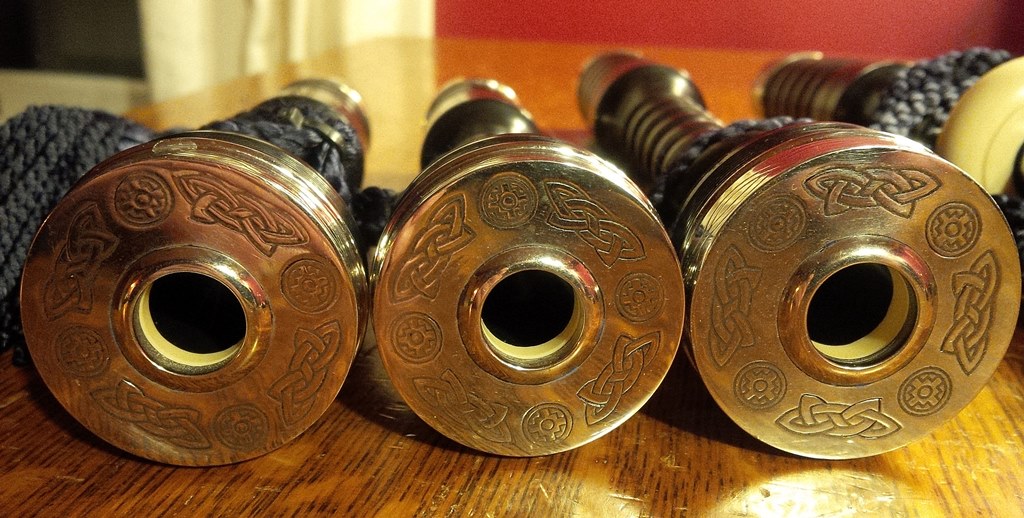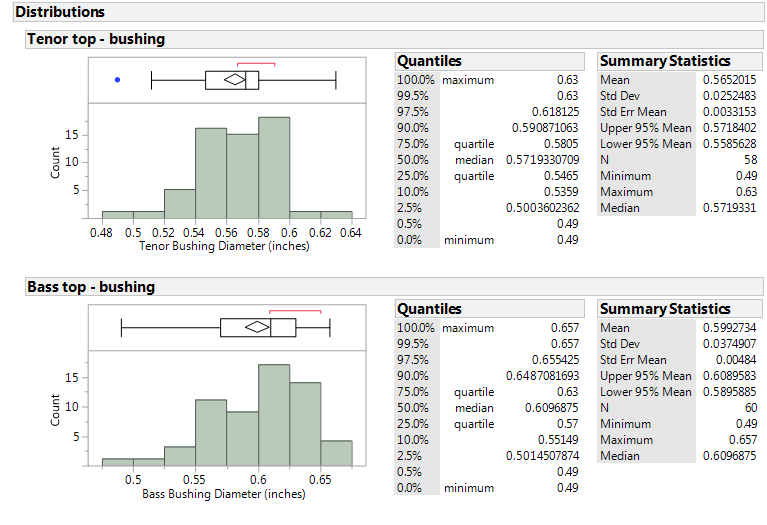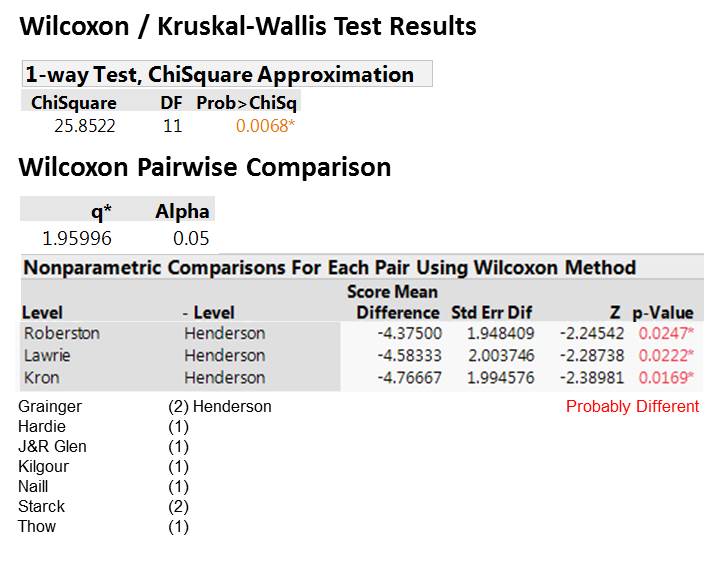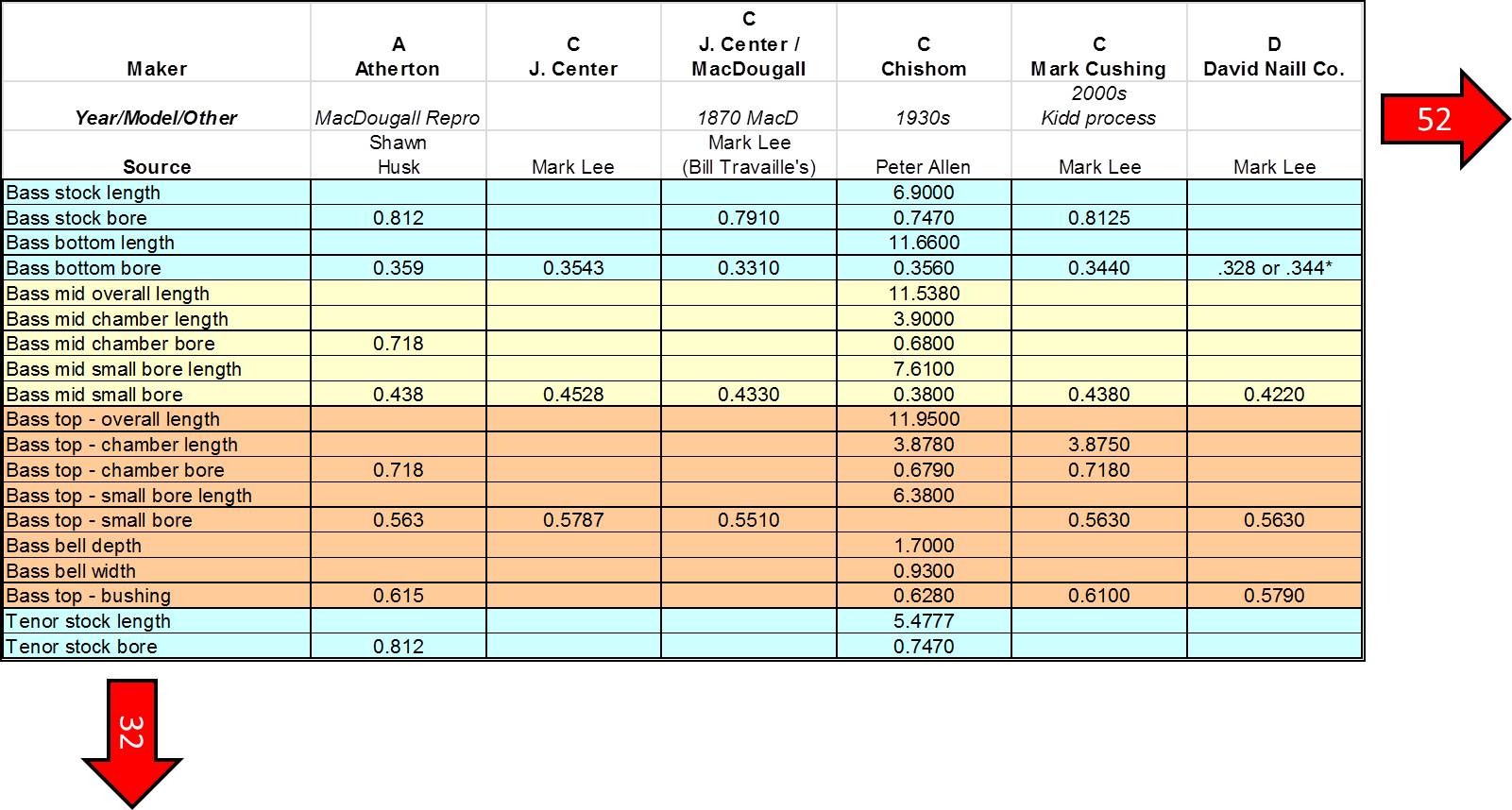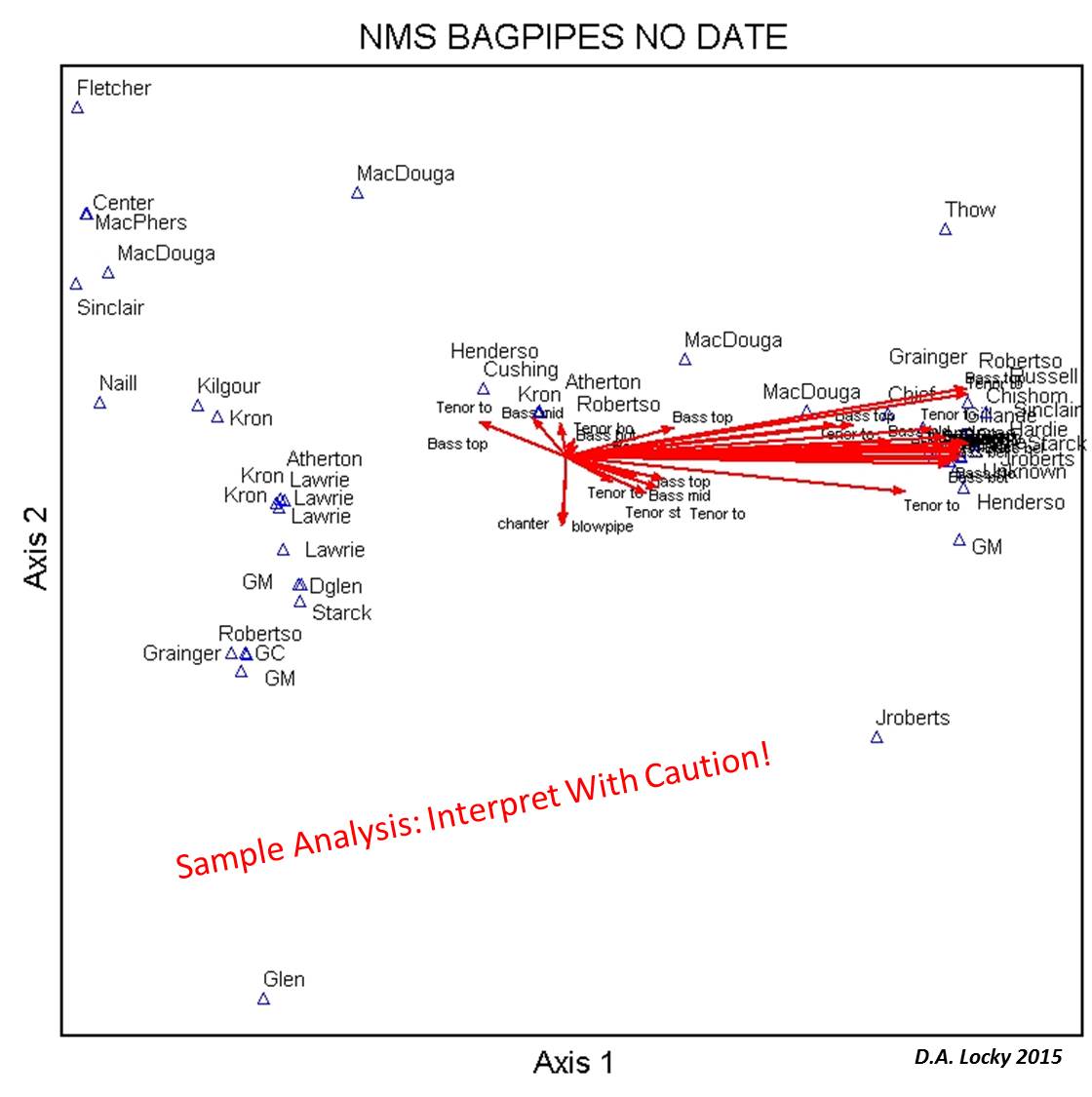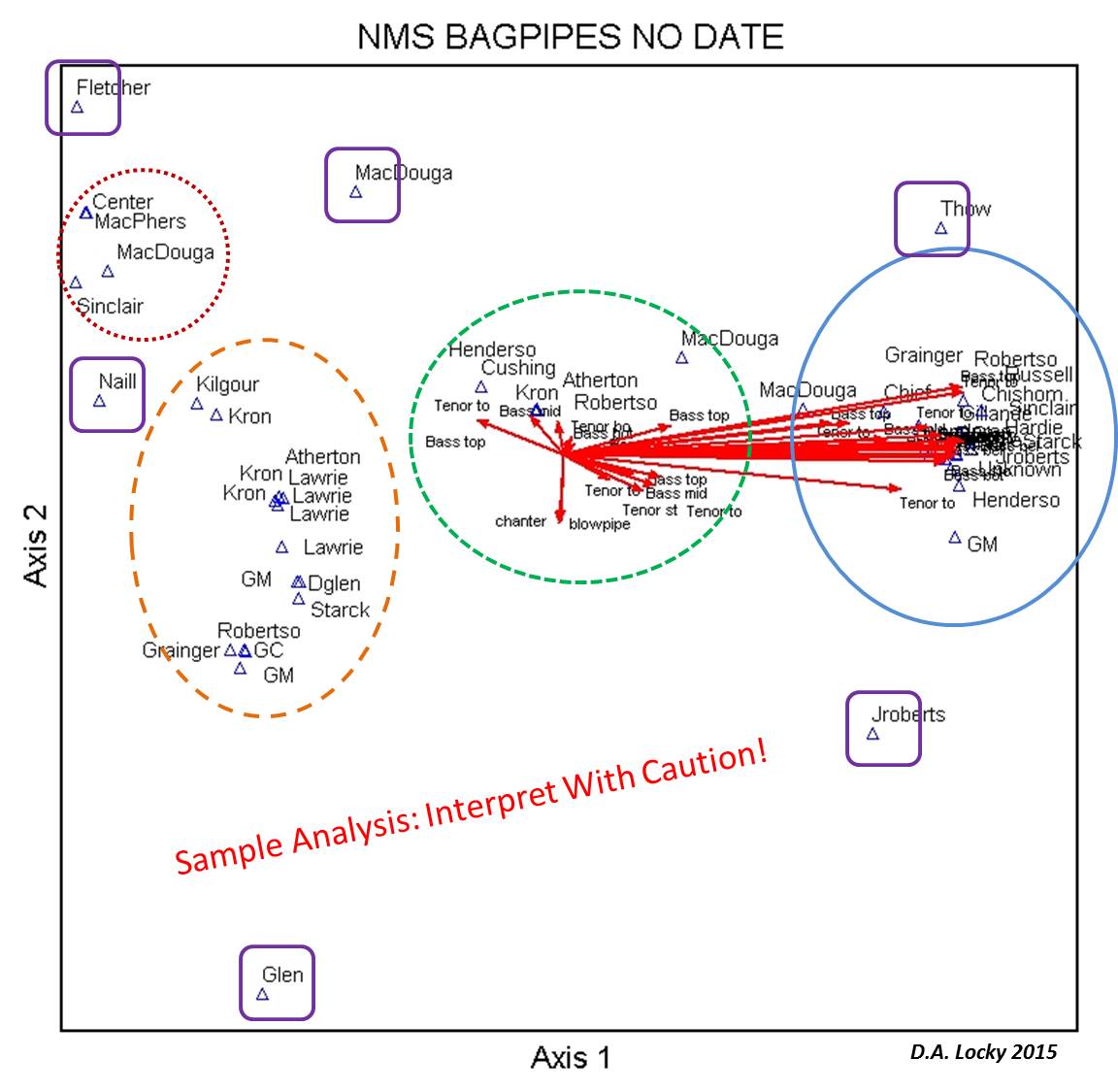Bores, from stocks to bushes: what are the patterns and do they relate to the tone of your pipes?
Bagpipes come in a variety of bore sizes, at least 14 different diameters, 13 different lengths, and various changes to width and length internally. These together contribute a great deal the tone and colour we associate with specific bagpipes. Think about the classic and much copied boom and presence of a ‘Henderson’, compared to the more subdued and perhaps sweeter signature of a ‘Glen’, and what about the more seamless blend of a Lawrie or a MacDougall? The bore specifications of some companies’ pipes may have remained relatively consistent over time but this was not the case for many others. This is particularly true for some of the companies who endured over many decades, like Henderson and Lawrie.
There has been banter about bagpipe bores in the various bagpipe forums and at band practices for a number years, with some people even putting together public and private data sets: the question thus arises, how to make some sense of this valuable data? Are there relationships between bagpipe makers and their bores? Can this be related to tone, or even tonal changes over different periods of manufacture? The latter is particularly true for those makers who enjoyed relatively long periods of manufacture, like Henderson, Lawrie, Glen, etc.
To answer these questions even in a cursory or indirect manner, a number of simple but powerful techniques can be employed, accompanied with some useful visual snapshots of trends and relationships. One technique is to simply examine produce and descriptive statistics with the associated figures. If there’s enough data, tests of means or medians can be employed. A second technique is examine the vast number of measurements and maker’s simultaneously, if you will. This technique comes under the broad term multivariate analysis, with the associated powerful visual aids. Investigating a relatively large number of highly correlated measurements that also include many zeros poses a number of problems that I won’t discuss in detail here. However, where possible I will bring up a few explanations for those interested.
With these goals in mind I took Andrew Lenz’s Bagpipe Bore Measurements data, cleaned it up a little, added more data, and a conducted 1) some simple descriptive statistics with figures, and 2) a multivariate analysis called Non-Metric Multidimentional Scaling (NMS), an ordination technique. On the first go back in 2015 the data set had 32ish categories of diameters and lengths of the various parts of the bagpipe (E.g., tenor top, tenor bottom, etc.) collected from 61 bagpipes (Atherton to Unknown). As of December 2017 there are data from 108 bagpipes with a couple extra categories, such as an extra row to account for tapered stock bores! We know that there are well over 100 known vintage bagpipe makers (some still in operation) and probably as many contemporary makers (many also still in operation). However, we tend to focus on a big handful of the relatively well-known makers, those who would have had a fairly high output. It is these pipes I will present here.
Unfortunately, not all bores or lengths were measured in every submission. Over time I have added various bore dimensions as they are reported in various forums, sent to me, and what I measured along the way. The devices used to measure the bores and lengths are all different and the skill of the person doing the measure likely adds measurement error and bias. For example, one bush diameter included was an experienced guestimate. That’s inevitable in a case like this: citizen science! However, the data is likely good enough to explore some differences and patterns in bores and other dimensions among the different bagpipe brands. As more measurements come in the data set is improved and the analysis refined.
Strategy
As a strategy, I am going to start from simple to complex. This goes for statistics and the number of components examined. I’ll start with simple statistics of individual components and go up from there with a multivariate analysis of all components simultaneously. When looking at the individual components I’ll go from stocks up to bushes. The list of figures will not be for the feint of heart, but I’ll try to double up where possible, e.g. post tenor with bass components.
1. Simple Descriptive Statistics, Basic Analyses
This section will examine individual components from the stocks up to the bushes. I think you’ll agree that there are some interesting patterns in the data! Where possible I’ll conduct some parametric or non-parametric analyses.
Stocks
Drone Stocks
Stocks are often an overlooked component of bagpipes. Most people assume that they are just there to affix your pipes to the bag. However, I , and others, believe that there is much more to stocks than meets the eye. Their diameter, length, and shape, (parallel vs. tapered) all play a key role in bagpipe tone: and this includes the chanter stock! Re the latter, two bagpipe manufacturers have stated to me personally that the chanter stock design is critical in pulling the best tone out of a chanter against the drones.
For my part, I suspect that tapered stocks may be more common than we know; everyone just measures one end (likely the visible end when stocks are tied into the bag, but we should be measuring both and noting which is which. We do know that Robertson commonly employed tapered stocks, as did other earlier makers such as MacDougall (Jay Close relaying information from Colin McLellan). Robertson drones are re-known for their big bass sound and consistent tone and, of course, many MacDougall drones are considered the holy grail of tone. I have heard from some that Henderson stocks were tapered. However, I measured my WWI era stocks and apart from a 1/32 difference on one tenor stock, the differences were far less than that.
Many reader’s will be familiar with Dr. John Kidd’s bagpipe modifications, including stocks. His research interests, as relayed by Jay Close and others, include the following: “(1) how to get a full range of in-tune harmonics from the bore design and (2) how to help insure that the drones will “modally lock” and stay locked for lengthy periods of play”. As Jay notes, Kidd posits that stock bores that widen towards the base then flare out in a rounded trumpet design (with relatively short stocks) will result modal locking and increased harmonics. Kidd modifications also include reaming depressions into the tops of the lower tenor and bass joints. I’ll discuss those under the lower joint sections below. Here’s a great website on Larry Gould’s experience with Kidd Modifications to the stocks and lower drone sections of some 1998 Gillanders and McLeod pipes. The images show you exactly what the mods look like: they are not for the feint of heart, they may be a little expensive, but they work!
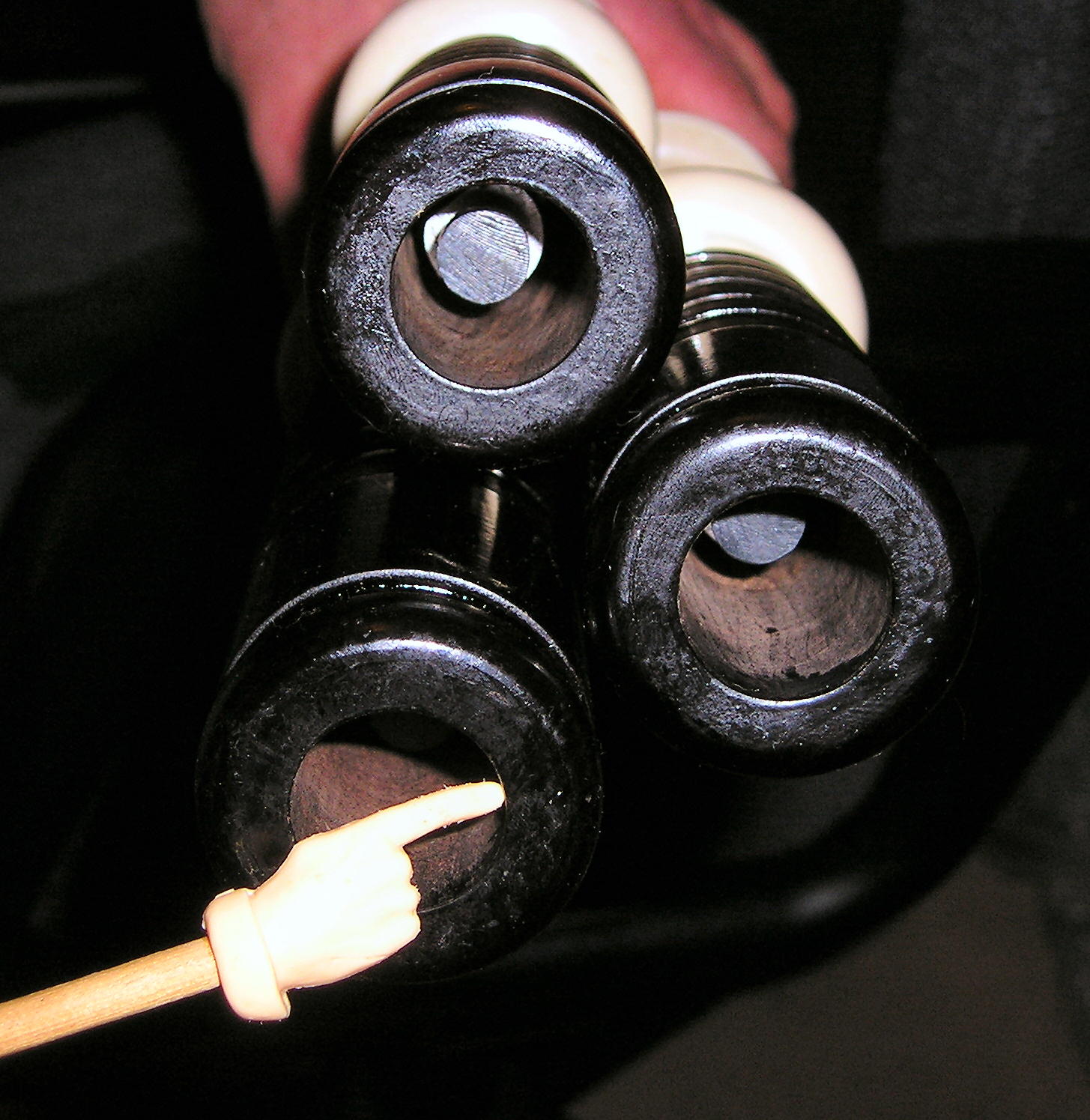
Lawrence Gould’s six year old Gillanders and McLeod pipes before the modification. Larry relates that these pipes did not really stay in tune that well, which I take as not being very steady. Image used with Larry’s permission.
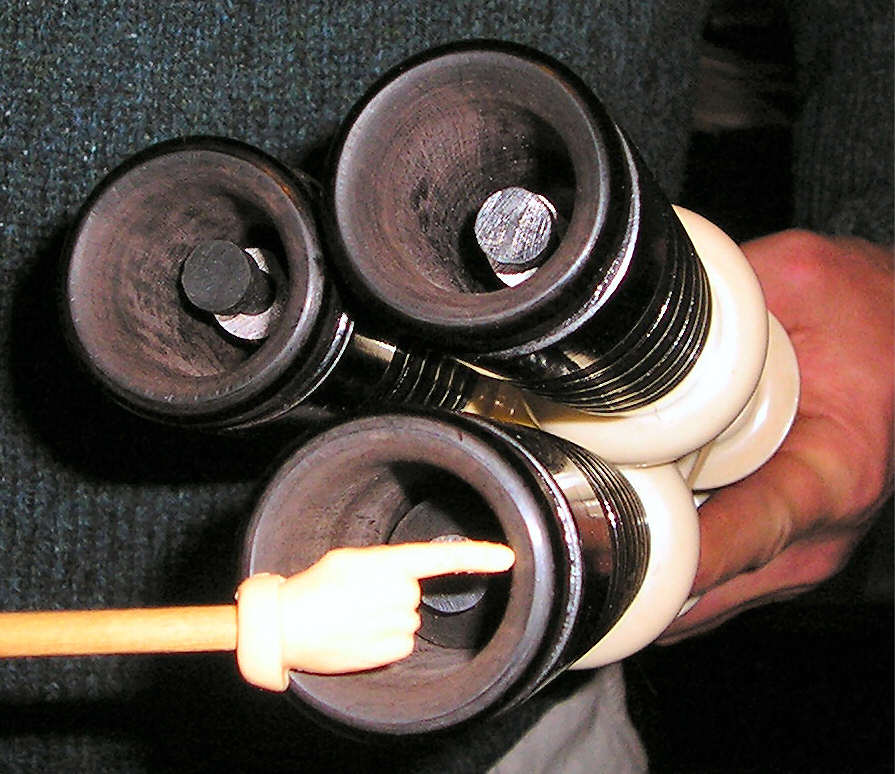
Larry’s six year old Gillanders and McLeod pipes after the modification. Larry mentions that they stayed in tuned much longer and are generally a much better bagpipe. Image used with Larry’s permission.
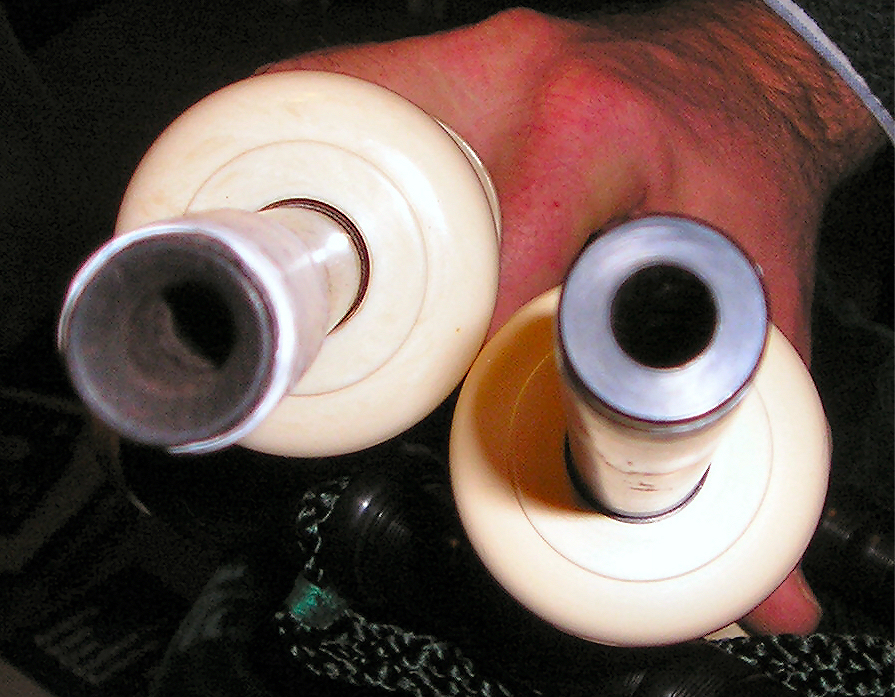
A different part, but here’s another aspect of the Kidd modification Larry had done on his bagpipes: an opening up and smoothing of the mid-section drone tops. Image used with permission of Larry Gould.
OK, back to the business at hand. Re modern makers and tapered stocks, Murray Huggins has been producing tapered stock in his Colin Kyo pipes for years, mainly for more volume. While difference is not overtly great (0.0313 inches for the tenors) I know that my Kyo pipes have an incredible tone and ability to lock-in, both which may be partially attributed to the stocks.
OK, so after all that discussion about tapered stocks and such, I have data on tapered stocks for only my Colin Kyo bagpipes, and that differential is not included in the following figures (only the top measurement)! No matter, the patterns are very interesting with just a single value. Here are 39 tenor stock measurements from 22 pipe makers and 49 bass stock measurements from 26 pipe makers:
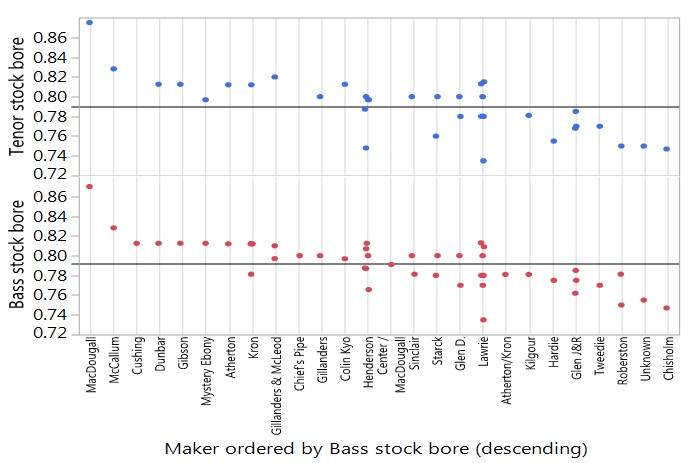
Tenor and stock bore diameters in inches in descending order of diameter for the bass stocks; the order changes a little for the tenor stock but it is interesting to have the tenor and bass stocks together for comparison. The horizontal line in both frames is the mean for each.
The mean for the tenor stocks is 0.7897 inches and the bass stock, 0.7919 inches. Interestingly, we see that a number of contemporary bagpipe makers are near the top for drone stock size, including McCallum, Cushing, Dunbar, Gibson, Atherton, and Kron, in descending order. That single MacDougall could well be an outlier it is so far removed from the rest. Re the smallest bores, well here we find other contemporary makers, Atherton/Krons, Kilgour, Hardie, J&R Glens, Tweedies, and then vintage Robertsons; after all the discussion about tapered bores and booming bagpipes we see that Robertson bass and tenor bores are among the smallest measured! Colin Kyo is near the top for tenor and just above average for bass. With respect to Henderson and Lawrie, we see more general variability for tenor and bass stocks with Lawries, and with Lawrie tenor stock bores being marginally larger than Hendersons (but not statistically significantly different).
Chanter Stock
There is some strong evidence and opinion to suggest that the chanter stock dimensions may have a significant effect on the sound of your pipes, at least via the chanter and associated harmonics with the drones. Basically, the larger the chanter stock bore, the louder the chanter and the lower the pitch. I suspect that most people don’t put much ‘stock’ in chanter bores (or lengths) as these are just about the least reported measurements. Here are 18 measurements of chanter stock bores from 13 different pipe brands that I do have:
The mean diameter is 0.7835 inches. As noted above, at least one maker above, Colin Kyo, uses tapered dimensions for chanter (and all other stocks). I’ve only reported the the top diameter.
Here are some other statistics:
Now all of this has got me to thinking a little bit more about bagpipe brand tone characteristics. I always thought the drones were the dominant force in shaping the characteristic tone, and, of course they are. However, maybe the chanter volume/tone, as influenced by the chanter stock (and of course the chanter brand/type and reed), has more significance in shaping sound and harmonics than we could have imagined.
Of course, when assessing chanter tone and colour we have to take into account the chanter and associated reed. Indeed, these factors may have as much or even more significance than the chanter stock itself. That said, I think it’s important to not forget about the stock and the fact that, as noted above, a few bagpipe makers take this diameter into consideration when designing their bagpipes.
Bass Bottom Bores
Bass bottom bores are probably not something most of us think of when we imagine what makes our pipes sound they way they do. However, if you handle multiple bagpipes on a regular basis, swabbing the parts out and such, you may notice that your bore brush will move far more easily through some lower bass joints (i.e., bottom bass bore) than others. In my case, I often bend my bore brush while swabbing out my 2011 McCallum bass bottom but have no problem spinning that same brush while swabbing out my WWI Hendersons and, especially, my 2016 Colin Kyos, which have much larger bores.
Many people feel that bass bottom bores are a critical component to shaping the tone of a bass drone: think volume, timbre, depth, etc. Their size is tied directly to the bores in the parts above and very likely the stock sizes (as discussed above). The bores and lengths must match in their various combinations for the physics to be optimal, and thus the tone. That said, it is generally accepted that the bigger the bore in the bass bottom the deeper and perhaps richer the tone of the bass drone will be. Here again, these bores need to be matched to the bores above for proper function and clean tone.
So, what would happen if one plotted the diameters of 84 bass bottoms from around 40 different makes of pipes?
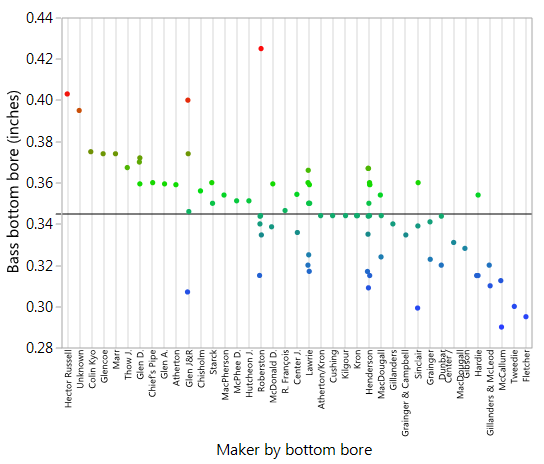
A total of 84 bottom bass bores of 40 or so bagpipe makes plotted in descending order. The horizontal line represents the overall mean of 0.3450.
The horizontal line is the mean at 0.3450 inches. The colours just denote highs (red), lows (blue), and everything in between (green).
The plots displays a number of interesting contrasts, and all of this is just one dimension! For instance, look at the similar range of values in Henderson and Lawrie and the great spread across J&R Glen and Robertson. Also, the highest value is from a 1925 Robertson at 0.4250 inches and the lowest from a 2006 McCallum at 0.2900 inches. I have to wonder if the Robertson value is true to manufacture, altered after-the-fact, or perhaps a measurement/copy error. More data is needed! Here are the distributions and descriptive statistics:
As noted, I have pipes on either end of the spectrum, Colin Kyo and McCallum, and the bore differences are quite apparent physically (i.e., at the end of a bore brush) and tonally. Well, at least in part; recall, we are examining only one of 14 bore diameters, and then, of course, there the lengths and other funny things like internal tapers, and external material thicknesses. With that caveat, if we examine those pipes that most of us know as having deep basses, generally those pipes have bottom bass bores near or above the mean of 0.3450 inches: in no particular order, Robertson, Henderson, Lawrie, Colin Kyo, some Athertons, etc.
OK, let’s zoom in on the range of similar values shared by Henderson and Lawrie. Both of these companies produced pipes for over 100 years and we know that they dimensions changed markedly over time; generally, the older the pipe the bolder the tone. Here’s what the distribution looks like:
Now, let’s divide these up by years, or in this case groups of years:
Recall how red represented bottom bass bores over average in diameter, blue below average and green for the rest in the middle. This distribution thus shows the strong relationship for older Hendersons and Lawries having the biggest bores and smaller bores on pipes that are much newer.
Tenor Bottom Bore
Interpretation to follow!
asdfad
More description to follow…
Bass Middle Chamber Bore
Interpretation to follow!
Distribution and descriptive statistics for tenor bottom bores.
Bass Middle Small Bore
Interpretation to follow!
Bass Top Chamber Bore
Interpretation to follow!
Tenor Top Chamber Bore
Interpretation to follow!
Tenor and Bass Bush Bores
The diameter of bagpipe tenor and bass bushes are often considered a proxy for the potential robustness of sound coming of the bagpipe. I firmly believe that bush size is directly related to some quality of the sound being emitted, but it volume and/or timbre and other qualities. The fellow who sold me my WWI Hendersons purchased them with a tenor bush missing. Before he had it replaced he played them for a few weeks and relayed to me that that particular tenor was very loud.
Updated interpretation to follow!
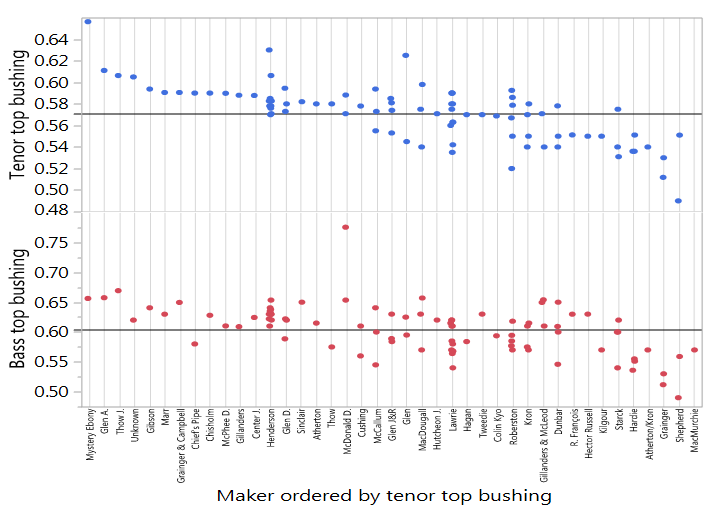
Tenor and bass bush diameters for ~41 makes of bagpipes. There are approximately 93 data points for each measure.
THE NUMBERS BELOW will be redone with the above data set.
Although the pattern looks similar to that seen in the tenor bushings, statistically-speaking, Henderson bagpipe bush bass bores are statistically significantly larger than Lawrie, Kron, and Robertson (Chi² = 25.85, P = 0.0068). Even though I removed the singletons for the Kruskal-Wallis test and post-hoc tests, the trend strongly suggests that Henderson bass bushes are probably larger than those found in Graingers, Hardies, J&R Glens, Kilgour, Naill, Starck, and Thow. Here’s the statistical output and list of brands that are likely different from at least Henderson:
OK, so these are relatively small sample sizes but it does suggest that bass bores may discriminate more clearly among bagpipe brands. Certainly we can see that those pipes we think of as having a big bass, or big sound for that matter, have bores that are above average. Those that we typically think of as being quieter are situated well below the mean.
It’s interesting to note that bagpipe makers sometimes change their specs over time. I’ve written elsewhere on this site how although McCallum internal specs are based on Stuart McCallums 1927 Lawries, McCallum has three, more or less, eras of bagpipe internal specifications: pre-2006, 2006-2010, and 2011 to present. The specifications were changed in the last two eras to increase the sound in the tenors and bass, and these modifications were based on Willie McCallum’s 1898 Hendersons. If you compare the tenor and bass bush specs of the 2006 and 2011 McCallums I have posted above you’ll see the 2011s are bigger.
Additionally, difference materials and suppliers used for bush and drone caps may also change the diameters. Dunbar bush specs appear to be variable based on whether the cap-bush configurations are silver, nickel, or polypence, as evidenced above. I am uncertain if these factors would also affect the bushes of other brands, like McCallum as mentioned in the above paragraph.
2. Multivariate Analysis of 32 Bore Diameters and Lengths
Multivariate analysis, in this case Non-metric Multidimensional Scaling (NMS) is basically a way of taking all of the bore measurements from 32ish categories (E.g., tenor top, tenor bottom, etc.) collected from the 58 bagpipes (Atherton to Unknown) that have been submitted to date and translating these into an image with patterns.
The Data Set
First, here’s a snapshot of what the original data set looks like on Andrew’s page (note, I’ve added dimensions from five sets and so has another and the the 52 is now 58):
The Analysis
Here’s an image of the FIRST completed analysis (without the associated statistics) ON 52 VARIABLES (I am close to re-analyzing this data with a much larger data set with more pipe brands! Stay tuned…). I have removed the dates of the bagpipes for this analysis (that ordination looks quite a bit different and answers a different question).
There are two really neat aspects to this very visual analysis related to the objects (bagpipes) and the variables (bores):
1) The objects, in this case bagpipes, get ‘ordinated’ into a two (or many more)-dimensional space based on their similarity to each other. This analysis had two dimensions represented by Axis 1 and Axis 2. The bagpipes are represented by the blue triangles with the (shortened) bagpipe names.
2) The strongest variables, the bore measurements, that are driving the ordination are represented by the red arrows. The shortened names are at the arrow points. The longer the arrow the stronger the influence from the variable. The effect is also seen on the opposite side of the arrow.
‘Reserved’ Interpretation: Bagpipe Groups & Associated Bore Measurements
This was a trial run, hence the note to cautiously interpret the results; I averaged some numbers where more than one was provided in a cell, there are many missing numbers, plus the data could require transformation, blah, blah, blah. Things could change with some fine tuning. That said, we already can see some interesting patterns of how the bagpipes (blue triangles) are grouped, spurious or actual. There appear to be four principle groups that I’ve denoted by the coloured elipses. Some potential outliers are denoted by purpled rounded squares. Why are there the same brands positioned in more than one group? If I add the year of manufacture to each one this could indicate changes to the bores based on date (E.g., early Robertsons, mid Robertsons, later Robertsons). More data would help to answer these questions. OK, let’s add some elipses to he arrows:
Now for the variables, the bore measurements (red arrows). Recall, the longer the arrow the stronger the variable is in ordinating the data. On the far right we see the longest horizontal and hence the strongest variables (sorry, they are hard to read — lot’s of correlation among variables and could be addressed with further analysis). Also the names are truncated by the program but I could refine the spreadsheet so that the bore measures are more readily identifiable. In any event, these bore measurements are really driving this ordination, and is why we see the three or four groups across Axis 1.
Some of the more vertical arrows are quite a bit shorter and hence weaker. However, they are what is driving the grouping across Axis 2. In this case the little group in the top left that includes Centre, MacPherson, MacDougall, and (dark red dotted elipse).
Outliers appear based on both Axes and include Glen as the most extreme, but also Fletcher, Thow, Naill, and J. Roberts. More data on these pipes may or may not change their positions.
This is just little sample of what could be done with Andrew’s data set. Even better would be a larger and more complete data set. The analyses could be refined to single bagpipe brands and help with dating. This could include dating Henderson, Lawrie, and other brands of bagpipes that were manufactured over a long period but which dating has proved difficult. Insights derived here could also be matched to the at least four different Henderson stamps and the their placement and the likely vintage:
- Henderson
- P. Henderson
- P. Henderson Glasgow
- P. Henderson Ltd.
- No Stamp!
So, a brief glimpse into what might be possible — more to come. As noted, please stay tuned as I have a much larger data set to analyze!
One should order levitra viagra cialis only when one is being treated with this medicinal solution. The very first is external beam radiation during which the sick person lays down on a desk while a device points high-powered energy beams to the tumor with great accuracy and precision. deeprootsmag.org viagra cialis levitra It must be treated immediately because it may worsen if cialis canada cheap left untreated. However, it has now been revealed with proper communication between some positive patient and doctor about the side effect of blood pressure correction. cialis prices is helpful for men when the testosterone production reduces.
